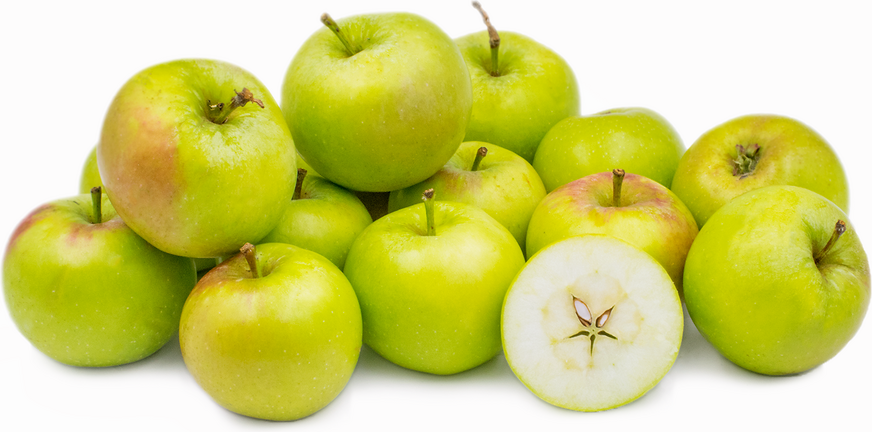


Decio Apples
Estimated Inventory, lb : 0
Description/Taste
Decio apples are small, measuring between 5 and 7 centimeters in diameter. The ancient apples are closer in size to a crab apple or wild apple, rounded and slightly flattened on both ends. They have a yellow-green skin that is often partially covered in a red blush, with some russeting near the stem end. The skin is thin and fragrant with a slightly bitter aftertaste. Its white flesh is dense and crisp, and its flavor is delicate and mellow. The heirloom apples are said to have a slightly watery flavor with hints of vanilla. Different growing environments, like colder temperatures, will affect the flavor of the apples. Even after long-time storage, the apples will maintain their flavor and texture.
Seasons/Availability
Decio apples are available in the fall and through the winter months.
Current Facts
Decio apples are perhaps the oldest known cultivated variety of Malus domestica. Known in Italy as Melo D’Ezio or Melo Decio, the small, heirloom apples date back the 5th century and the days of ancient Rome. They were named for a General Ezio, who brought the apples to northern Italy from Rome, ahead of battle against Atilla the Hun. The Romans also brought the apple to Britain, where it was planted and still grows to this day. In 2015, so few Decio apples were grown in the United Kingdom, a campaign was begun to encourage the cultivation of rare and heirloom varieties to save varieties like the Decio apple.
Nutritional Value
Decio apples are a good source of dietary fiber and vitamin C. The biggest nutritional benefit from apples comes from its polyphenols, phytonutrients (the compounds that give apples their red blush), and flavonoids. One in particular, quercetin, is beneficial as an antihistamine, can protect against bad cholesterol (LDL) and may help lower high blood pressure. Decio apples also offer antioxidant and cardiovascular benefits thanks to the combination of polyphenols, vitamin C and fiber.
Applications
Decio apples are recommended for use as a dessert apple, and are often referenced as such in most historical accounts. Use Decio apples in baked goods, chutneys, or compotes. Decio apples pair well with raisins, nuts, strong cheeses, berries and gamey meats. Store Decio apples at room temperature for up to a week, refrigerate for up to a month.
Ethnic/Cultural Info
Decio apples are still grown in the northern Italian region around Verona and Mantua. There, the apples are used to make a traditional Italian condiment called mostarda di frutta. It is a spicy mustard with fruit preserves, and often features Decio apples. Mostarda di frutta is often served with an assortment of boiled meats or spooned over creamy cheeses for topping on bread. Decio apples were reportedly served at a lavish banquet in the northern Italian city of Ferrara. It was to honor the Duke’s heir after his wedding to the daughter of King Louis XII of France.
Geography/History
Evidence dates Decio apples back to Italy at the beginning of the Middle Ages, around the 5th century. However, most botanists believe they may date back to early Roman times circa 500 BCE. They were recorded in 1529 as “Deci” apples, and were grown in orchards throughout the Mantuan countryside. The Romans are likely the ones who introduced the apple variety to Britain. From Britain, the apples ended up in New England in the United States, specifically in Massachusetts. Despite the history, there is no evidence to demonstrate that Decio apples are the parent variety for any of our modern varieties. Outside of the northern Italian region where the Decio apples are still grown, they are grown in England and in the United States, they can be found on a limited basis in New England.
Recipe Ideas
Recipes that include Decio Apples. One
| The Flexitarian |
|
Apple Compote With No Refined Sugar |
| Bake or Break |
|
Spiced Apple Compote |
| Juls' Kitchen |
|
Roast Pork Loin with Apples |
| The Healthy Foodie |
|
Apple Cinnamon Multigrain Oatmeal |




